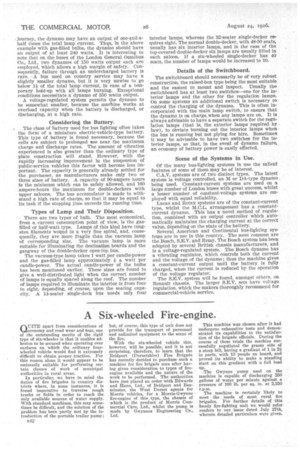A Six-wheeled Fire-engine.
Page 60

If you've noticed an error in this article please click here to report it so we can fix it.
QUITE apart from considerations of economy and road wear and tear, one of the outstanding merits of the rigid type of six-wheeler is that it enables adhesion to be secured when operating over surfaces on which the ordinary fourwheeled vehicle would find it extremely difficult to obtain propertraction. For this reason alone it would appear to be eminently suitable for performing certain classes of work of municipal authorities in rural areas.
In particular, we have in mind the duties of fire brigades in country districts where, in some instances, it is found imperative to traverse rough tracks or fields in order to reach the only available sources of water supply. With standard machines, this may sometimes be difficult, and the solution of the problem has been partly met by the introduction of the portable trailer pump ; B42 but, of course, this type of unit does not provide for the transport of personnel and unlimited equipment to the scene of the fire.
With the six-wheeled vehicle this, bowever, will be possible, and it is not surprising, therefore, to learn that the Bridport (Dorsetshire) Fire Brigade has recently decided to purchase such a machine for fire brigade uses after having given consideration to types of fireengine available and the nature of the work to be performed. The authorities have just placed an order with Edwards and Hann, Ltd., of Bridport and Beaminster, the West Dorset agents for Morris vehicles, for a Morris-Gwynne fire-engine of this type, the chassis of which is the product of Morris Commercial Cars, Ltd., whilst the pump is made by Gwynnes Engineering Co., Ltd. This machine was chosen after it had undergone exhaustive tests and demonstrated its capabilities to the satisfaction of the brigade officials. During the course of these trials the machine successfully negotiated the grassy side of a steep hill, having a gradient of 1 in 2i in parts, with 13 people on board, and proved its ability to make a standing start on this gradient with a full load up. The Gwynne pump used on the machine is capable of discharging 250 gallons of water per minute against a pressure of 100 lb. per sq. in. at 2,250 r.p.m.
The machine is certainly likely to meet the needs of most rural fire brigades. For further details of this . handy fire-fighting unit we would refer. readers to our issue dated July 27th, wherein detailed particulars were given.




































































































